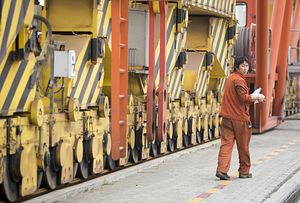In early September, China’s State Council issued guidelines on the development and modernization of the maritime and shipping industry in what China’s leaders lament to be an “oversupplied and loss-making sector.”
What’s more significant is that China’s own policies are to blame. Beijing has long considered shipbuilding to be a strategic industry, and it has employed a robust range of mercantilist subsidies to ensure an unfair advantage in world competition. In the process, an inefficient, unproductive industry that, while something of a jobs factory from a social policy point of view, has inflicted itself on world shipbuilding.
To be fair, China has made no secret of offering nearly a 20 percent subsidy on prices for Chinese ship buyers, or giving preferential interest rates to Chinese shipbuilders, or encouraging banks to finance shipbuilding through issuing U.S. dollar bonds in order to minimize cancellations and to assist the two largest shipyards, China State Shipbuilding Co. Ltd. and China Shipbuilding Industry Corp. The State Council has even guided shipyard mergers and acquisitions, encouraged by the creation of an investment fund and the injection of easy-access capital.
But not enough analysts have specifically studied China’s 2006 “Long and Medium Term Plan” to enlarge the shipping industry by 2015. The effort has included huge Chinese steel subsidies, a shipyard’s biggest raw material cost, that have helped to create excess capacity, increased exports, and depressed worldwide prices. In 2005, China went from being a net steel importer to a steel exporter. In 2006, China became the largest steel exporter in the world, up from fifth largest the year before. In 2007, energy subsidies to China steel were found to be around $15.7 billion – a 3800 percent increase since 2000. Thus, Usha and George Haley show in Subsidies to Chinese Industry that with no discernable cost advantage, the Chinese steel industry could sell steel for 25 percent less than steel made in the U.S. or Europe. The Harleys have found that that the manufacturing cost advantage does not come from cheap labor. In the steel industry, as with shipbuilding, it is massive government subsidies, some of them well disguised, that keep production prices down.
That unfair and illegal subsidies distort trade, resulting in inefficient production, is hardly news. In deciding whether a subsidy flouts trade rules the World Trade Organization (WTO) uses a “price gap” approach. The idea is straightforward: If a country is producing and selling something at a discount to what others are charging, there is probably something improper going on.
A simple price gap analysis shows that Chinese ships cost 7.3 percent less than rivals’ ships. Controlling for quality differences, they should be around 3 to 5 percent cheaper, which leaves a 4 percent gap, and not much justification for WTO rage, if such a thing existed. It nearly goes without saying that China has never acknowledged the presence of any subsidies in its steel or shipyard industries in the WTO. The hidden benefits of tolerating losses at state-owned shipyards, or the generous subsidy for scrapping older cargo ships and tankers, go mostly unnoticed.
But it’s hard to miss a typical pattern in Chinese manufacturing. Subsidies lead to massive excess capacity, increased exports art predatory prices, and depressed worldwide prices. Then there is the hollowing out of the industrial base of another country and a systematic skewing of comparative advantage to protect Chinese jobs.
Recently in a 2014 working paper, Myrto Kalouptsidi of Princeton University has provided a new way to spot subsidies and measure their impact. Using detailed quarterly data on factors like a shipyard’s age, size, capacity, and staffing levels, Kalouptsidi estimates cost factors – the relationship between a yard’s output and its cost of production – for 192 yards across China, Japan, and South Korea and Europe. By analyzing data between 2001 and 2012, she can isolate the impact, for example, of China’s 2006 policy.
Her conclusion is that Chinese government help artificially lowered Chinese shipyards costs by between 15 and 20 percent! In other words, subsidies reduced Chinese shipyard costs from 2006 to 2012 by roughly $5 billion. The bigger story is in world resource misallocation, and misaligned costs and production with only minor surplus gains for shippers. Absent China’s meddling in the market, Kalouptsidi shows that shipyard market share for especially Japan and also for South Korea would have been greater. Markets other than shipbuilding could benefit from this kind of analysis, if only to confirm that too many subsidized products from China travel aboard subsidized Chinese ships with subsidized Chinese steel.
Tom Thompson works for the U.S. Maritime Administration (MARAD) in Washington. His opinions are his own and do not reflect those of MARAD, or of any other agency of the United States Government.

































